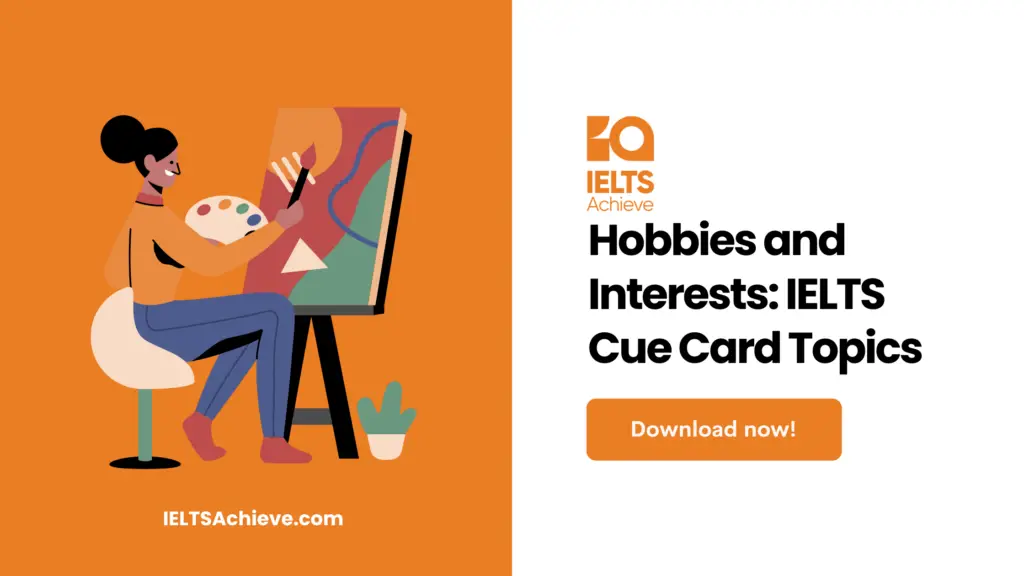The IELTS Speaking exam is divided into three parts, and Speaking Part 1 is generally considered an easy task.
In this part, the examiner asks the test taker to introduce themselves in a few brief sentences. Practising these questions for Part 1 of the cue card can help you achieve a good score on your IELTS Speaking test.
Do you like art?
I have a deep appreciation for art. I find creativity and expression fascinating whether it’s paintings, sculptures, or even digital art.
Do you think art classes are necessary? (Why?) / How do you think art classes affect children’s development?
I strongly believe that art classes are necessary, especially for children. Art provides a platform for self-expression, fosters creativity, and enhances critical thinking skills. It allows children to explore their imagination and develop their unique perspectives, which can benefit them in various aspects of their lives.
Are you good at art?
I wouldn’t say I’m a master artist, but I do enjoy creating art. I have been practising and improving my skills over time, and it’s a fulfilling process for me.
What kind of paintings do people like?
Tastes in paintings can vary significantly from person to person. Some individuals appreciate realistic landscapes or portraits, while others gravitate towards abstract or contemporary art. Ultimately, it depends on personal preferences and the emotional connection that a painting evokes.
What benefits can you get from painting as a hobby?
Painting as a hobby offers numerous benefits. Firstly, it serves as a form of relaxation and stress relief, allowing individuals to immerse themselves in a creative and therapeutic activity. Additionally, it encourages self-expression, boosts confidence, and improves focus and concentration. It also provides a sense of achievement when you see your artistic skills progress over time.
How often do you visit art galleries?
I try to visit art galleries as often as possible. Whenever there is an exhibition or a new collection on display, I make it a point to explore and appreciate the artwork. It’s a great way to immerse myself in different artistic styles and gain inspiration.
What kinds of things do you like to draw?
I enjoy drawing a variety of subjects, ranging from natural landscapes to portraits of people. I also find joy in creating whimsical illustrations and exploring abstract concepts. It’s a way to experiment with different techniques and unleash my creativity.
Is it easy to learn how to draw?
Learning to draw can be both challenging and rewarding. While some individuals may have a natural inclination towards art, anyone can develop their drawing skills with practice and guidance. Taking art classes or following tutorials can provide valuable techniques and insights that make the learning process more accessible.
Vocabulary:
Self-expression: The act of expressing one’s thoughts, feelings, or ideas.
Example: Through painting, I find a means of self-expression where words fall short.
Creativity: The ability to think imaginatively and generate original ideas or works.
Example: The artist’s creativity shines through their unique and innovative artworks.
Critical thinking: The objective analysis and evaluation of an issue to form a reasoned judgment.
Example: Art classes help foster critical thinking skills by encouraging students to interpret and analyze different artworks.
Imagination: The faculty of creating mental images or concepts not present to the senses.
Example: Children’s artwork often showcases their vivid imagination and limitless creativity.
Perspectives: A particular way of viewing or understanding something.
Example: Art allows individuals to express their perspectives on social issues and personal experiences.
Therapeutic: Relating to the healing or soothing of the mind, body, or emotions.
Example: Engaging in painting as a hobby can have a therapeutic effect, helping individuals relax and reduce stress.
Immersion: Deep involvement or complete absorption in an activity or subject.
Example: When visiting art galleries, I immerse myself in the artworks, appreciating the details and emotions they convey.
Whimsical: Playfully quaint or fanciful, especially appealingly or amusingly.
Example: I enjoy creating whimsical drawings that transport viewers into a world of imagination and wonder.
Techniques: Methods or approaches used to accomplish a particular artistic or creative effect.
Example: Learning different drawing techniques, such as shading and perspective, can significantly enhance one’s artistic skills.
Accessible: Easily understood, obtained, or reached.
Example: Art classes aim to make the learning process accessible to individuals of all skill levels, including beginners.
Inclination: Natural talent, tendency, or preference towards a particular activity or subject.
Example: Some people have an innate inclination for art and effortlessly excel in various artistic pursuits.
I hope these definitions and example sentences provide further clarity on the vocabulary words and how they can be used in context.


